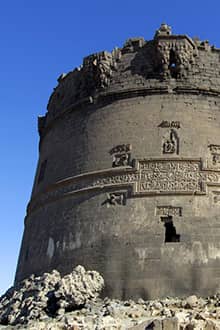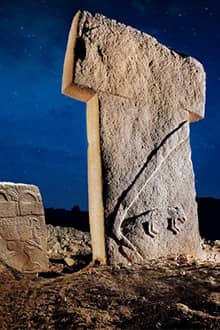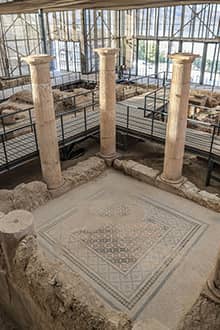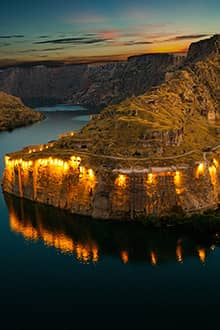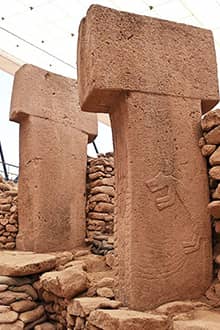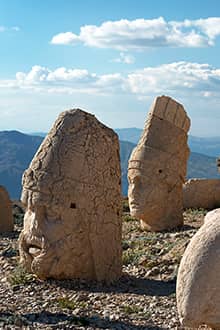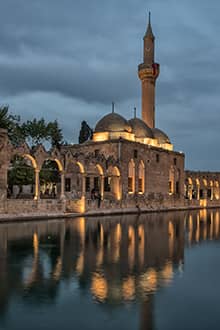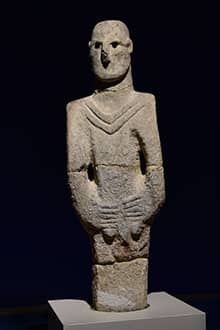

see
Mesopotamia Türkiye
Göbeklitepe, the Zero Point of History
Discovering Göbeklitepe, the oldest known monumental structure of faith in the world, turned upside down what we know so far about hunter-gatherers, our prehistoric ancestors. We knew them as groups of people who migrated from place to place, stayed in the same place as long as they found animals to hunt and plants to gather, living in quite primitive small communities. However, Göbeklitepe, dating back to 9,600 BCE, revealed that they were not as primitive as we thought. They were socially organized and were able to come together for a common purpose, and they were able to erect Göbeklitepe’s T-shaped stone pillars weighing up to 15 tons each, with carved animal reliefs, that were made with awe inspiring workmanship and built a cult/gathering center for themselves.
Göbeklitepe was included in the UNESCO World Cultural Heritage List in 2018 and became the 18th UNESCO World Culture Heritage Area of Türkiye. If you want to learn much more about this intriguing 12,000-year-old history, and feel the power of faith, then Göbeklitepe is waiting for you.
Halfeti
Halfeti, founded in 855 BCE by King Assyrian Shalmanaser II, is located 102 km east of Gaziantep and was one of the villages affected by the Birecik dam and its reservoir. Unlike others, it was not submerged by the waters of the Euphrates, but part of the village did not escape submersion.
You can see the mosque on the edge of the new lake. If you look at the surface of the water, you will see the outlines of the houses that were submerged, an almost surreal sight.
Although these changes have transformed the area into a tourist attraction, there aren’t many accommodation options in Halfeti, mostly because the village is part of the “Cittaslow” movement that advocates a relaxed and leisurely urban culture.
Next to Halfeti there is a fortress – Rumkale – originally built by the Assyrians, and an abandoned, also semi-submerged village, Savaşan Köyü.
You can take a boat trip from Halfeti to Rumkale, where there is an interesting fortress on top of a hill, and up to Savaş.
To get to Halfeti from Gaziantep or Şanlıurfa, you’ll first have to take a shuttle to Birecik and then, from the market, another one to Halfeti.
Mount Nemrut
Mount Nemrut has been a UNESCO World Heritage Site since 1987. It’s famous for the sculptures found at its summit, created by the Kingdom of Commagene, a political unit that was built on the fallen empire of Alexander the Great.
This kingdom lasted only for 200 years and was later incorporated into the Roman Empire. But for as long as it existed, it was well-known for its necropolis and tombs. It’s actually the final resting place of King Antiochus I and it’s his memorial that we find at the top of Nemrut Dağı.
The statues are between eight and nine metres tall, and there are representations of the monarch, lions, eagles, and various Greek, Armenian, and Median deities. Originally the statues were in a seated position, but at one point in time they were vandalized, their heads were removed and left scattered in the places where see them today.
There are also bas-reliefs and, of course, the mausoleum that some suppose must be the tomb of the king decorated in the same style of the sculptures. But not all archaeologists are convinced that we have yet found the king’s tomb.
Zeugma
Zeugma was founded in 300 BCE by Seleucus I Nicator, one of the generals of Alexander the Great. Its named after a bridge that connected the two banks of the Euphrates and Zeugma means “bridge” or “passage” in ancient Greek.
In 256 BCE Zeugma was conquered by the Romans, and the transition to the Kingdom of Byzantium was natural. In 256 the king Sassanid Shapur I destroyed the city, which for a long time did not recover from the damages suffered and indeed never returned to the level of prosperity that it had had previously.
The attacks of the Arabs led to the abandonment of the city. The site was later inhabited, but in a disconnected way from the old Zeugma.
Like several other places of historical importance located in the region, Zeugma was partially submerged due to the creation of a dam and its reservoir. It’s estimated that 25% of the area of the city is currently under the waters of the Euphrates.
The magnificent Mosaic Museum of Zeugma, in the city of Gaziantep, was created with elements removed from the site before it was underwater.
Anyway, there’s still much to explore and to be excavated by archaeologists who continue to work on Zeugma.
Hasankeyf in Batman
The most stellar period of Mesopotamia was under Artukid rule after 1101 AD when Hasankeyf became the capital, and one of the most important centres on the Silk Road. It was known as Hısn Keyfa (Rock Castle) at that time. The bridge which once spanned the Dicle (Tigris) River and connected the two parts of the city with the ruined palace inside the citadel evokes the ghosts of a vanished dynasty. The 15th century Zeynel Bey Mausoleum, attractively decorated with turquoise tiles, shows Persian influence.
Birecik
The city rises on the western bank of the Euphrates River, with some developments on the opposite side of that waterway. Its name may come from “Birtho”, which means “hill” in Assyrian. There is no trace of such a hill nowadays, but the archaeologists suspect that the fact that only one of the twelve bastions that defended the castle exists could indicate the past existence of an elevation.
It’s an old city, founded in around 2000 BCE, although there is not much left of its oldest past. It was ruled by Hittites, Assyrians, Persians, Byzantines, and Arabs. It was known to the Crusaders, was destroyed by Timur in the 14th century.
Visitors should pass through the old castle, walking along its walls, where the most picturesque part of the city is. Bird lovers come to Birecik to see the colony of the northern bald ibis, known here as Kelaynak. This species is almost extinct, but in Birecik you can easily spot them between February and July.
The ancient cemetery from the early Bronze Age is also a must-see, which was used for 500 years and where more than 300 tombs were excavated between 1997 and 1998.
Midyat
Midyat is located in the province of Mardin and has a population of about 60,000 people and a history that gets lost in the depths of time. It’s mentioned in Assyrian inscriptions in the 9th century BCE under the name Matiate and since that time was part of several empires and kingdoms having been ruled by Assyrians, Armenians, Medes, Persians, Greeks, Romans, Byzantines, Arabs and Ottomans.
Its historic centre seems like something out of the tales of the Arabian Nights. A world made up of alleys lined with old houses adorned with carved stone, fabulous bazaars, and Muslim and Christian temples that you’ll come across at the most unexpected spots.
If you can, visit the monastery of Mor Abrahom Hobel, near the historic centre, but be aware that it may be closed.
The Voices of Coppersmiths Bazaar (Bakırcılar Çarşısı)
Coppersmiths Bazaar, which has been full of hammer sounds for about four centuries, takes its visitors to another era with its wood-covered shops and stone-paved streets. The bazaar is a complex of bazaars where many handicraft masters produce. The art of coppersmith, which gives its name to the bazaar, continues its existence today, as copper items still occupy an important place in city culture, especially in the kitchen. Copper items are a very popular souvenir for tourists as well as for local people of Gaziantep.
However, the magic of Coppersmiths Bazaar does neither originate from the traditional shopping experience of tourists nor from the sparkle of copper. The magic is in the sound of the hammer, which the masters who open their shop in the morning skillfully hit the copper one after another to produce the magnificent products. This is such a symphony that its notes, which have been passed down from master to apprentice for hundreds of years, are inspired by an endless cycle from human to copper and copper to human. Even though there is no conductor in the middle, copper masters know which notes to be piano and which to be forte and turn that gentle copper material into a wonderful piece with their experienced strokes.
The Tomb of İsmail Fakirullah
The history of unique light event dates back to 1734. İbrahim Hakkı His Holiness once said, "What good could I expect from the sun that does not shine upon the gravestone of my master?" following the death of his master İsmail Fakirullah, and he paved the way for great scientific wonders in terms of astronomy and architecture.
İbrahim Hakkı His Holiness, who built an 8-angled tower with a height of 10 meters right next to the tomb his master was buried in, also built a dry-stone wall on Eastside of the tomb. On equinox days in which duration of the day and of the night are equal (March 21st and September 23rd), sunlight rising from the valley behind the castle, hits the wall. Since sunlight cannot penetrate through the castle, it cannot reach the city of Tillo. Sunlight only enters through the window on the wall and it refracts on the prismatic structure on the tower. Then, the light passes through the window of the tomb, and lightens the gravestone of the sarcophagus of İsmail Fakirullah His Holiness. It is possible to see this extraordinary event each year on March 21st and September 23rd.
The Islamic Science History Musuem
The Islamic Science History Museum in Gazianntep shines a light on the Golden Age of Islam. Artifacts from the fields of medicine, chemistry, physics, astronomy, cartography, and the maritime sciences are exhibited at the museum. There are 103 inventions by 54 scientists in the museum, some of which are also interactive.
Keçi Burcu (Goat Tower)
Keçi Burcu (Goat Tower) is the oldest and largest tower of the Diyarbakır City Walls and is near Mardin Kapı. The Hevsel Gardens are 700 hectares of cultivated, fertile lands near the Tigris River where in the past all of Diyarbakır’s produce was cultivated. The Dicle (Tigris) Brigde, which is known locally as “On Gözlü Köprü” (Ten Arches Bridge) dates back at least 1,000 years. The nearby Kırklar Mountain is trully magnificent.
The Grand Mosque of Diyarbakır
The Grand Mosque, one of Diyarbakır’s symbols, is one of the rare mosques in which the four sects of Islam pray together. The mosque is one of the oldest in Türkiye and was built by the Seljuk Sultan Melik Şah (Malik Shah) in the 11th century.
In the garden of the Grand Mosque of Diyarbakır there is a sundial designed by Ismail al-Jazari (1136-1206). Al-Jazari was a polymath and a scholar who is considered a prime representative of the Golden Age of Islam. Al-Jazari was the first scientist and engineer to carry out work on cybernetics. He was the chief engineer at the Artuqid Palace, the seat of the eponymous dynasty inside the Diyarbakır City Walls. His book The Book of Knowledge of Ingenious Mechanical Devices (1206) was later translated into several European languages and became a source and inspiration for many later mechanical inventions throughout the world.
Mausoleum of Noah (Hz. Nuh Türbesi) in Şırnak
The mausoleum of Noah, the second father of humanity since the flood, is located in the mosque, which called with the same name. Both the shrine and the mosque have been restored in recent years.
The place where Noah was buried was first converted into a synagogue, then a church and a mosque in 639. This shrine is one of the oldest in the world.
The famous historian İbnülesin Firuzabadi, Evliya Çelebi, Katip Çelebi, Ebubekir Helevi and Babilli Berassus (Bersis) write that this tomb belongs to Noah. The tomb of Al Jazeera, the founder of cybernetics, is also inside this mosque.
Mesudiye Madrasa
Mesudiye Madrasa is located at the northern wing of the Grand Mosque of Diyarbakır, adjacent to the eastern half of the mosque. This is the first madrasa that was built in Diyarbakır. There are two rotating stone pillars that are placed next to the mihrab in the yard of the madrasa. These pillars were placed for the purpose of identifying any collapse in the building that might occur due to an earthquake. You can rotate the pillars with your hands and examine this magnificent work of art that has been standing for approximately 800 years.
Bozova (Euphrates) Waterfalls
The best place to admire the Euphrates, the largest river giving life to Mesopotamia, is between Şanlıurfa and Adıyaman. You can wet your feet in the water at the nearby Bozova (Euphrates) Waterfalls and touch this sacred river which has given life to so many civilizations. This is the perfect spot to photograph the Euphrates.
Northern Bald Ibises (Kelaynak)
The old residents of Birecik say, "The sky gets dark when the northern bald ibises appear." Nowadays, there are 150 nothern bald ibis left in the world. These birds only live along the Euphrates River in Birecik district of Şanlıurfa. You can see examples of this rare bird species at the Bald Ibis Breeding Center located 3 km north of Birecik district center. Experts and volunteer guides at the center are waiting to tell you all about these amazing birds?
The Art of Filigree
The art of filigree is an intricate engraved tale. The history of this fine craft is as old as Mesopotamia itself, dating back to approximately 3000 BCE. Filigree is the detailed metalwork of twisting fine threads of silver or gold, knot by knot. Today, most filigree workshops are in Mardin city center and Midyat.
Assyrian Culture
While here, would you like to participate in a Assyrian service? Assyrians pray five times a day like Muslims. You can attend an Assyrian service in Mardin. The hymns will move you and, if you wish, after the service you can learn more about this ancient church and the community’s culture from the friendly and helpful staff.
Olive Oil Production
Would like to see how olive oil is extracted with traditional methods in Kilis, where the land is covered in never-ending olive groves?
Olives, which mature at the end of fall, are collected and brought to the factories to be ground in Kilis. However, in order to extract olive oil using traditional methods, the olives are brought to olive workshops called mahsara. These olives are ground by millstones continuing a millenia-old tradition. The only difference is that in the past people used to use horses, donkeys, or mules, while today, this duty is undertaken by engine power.
Beginning in mid-November, you can visit olive mills and see for yourself how the olive oil is extracted.

